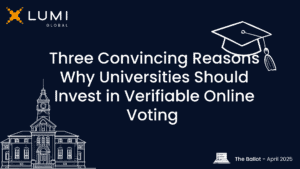Completing tasks over the internet will always come with some risks, casting ballots included. But fear not! In this edition of The Ballot, we examine three potential issues you might encounter when voting online and what our system Electa offers to help resolve them.
Issue #1: Keeping Voters' Choices Private
When we cast ballots in a traditional setting, we expect a reasonable degree of privacy: no one should be able to see for whom or what we voted, and no one should be able to tie our ballots back to us once they are in the ballot box. The same rules should apply when voting online, but this is sometimes presented as a tradeoff: you can have secrecy, or you can have security, but you can’t have them together.
We respond, “Why not both?” In order to keep votes confidential and voters anonymous, Electa utilizes end-to-end encryption to secure votes before they enter the digital ballot box, after which they can only be decrypted by multiple election trustees when it is time to generate results. Additionally, prior to decryption, mixnets present in Electa “mix up” votes to separate voters from their ballots prior to decryption to keep them anonymous.
Issue #2: Protecting the Ballot Box
Nobody likes uninvited guests. We would say the same applies to voting: an election is only free and fair when ballots are cast only by those who have the right to do so after they are properly authenticated. When voting online, multifactor authentication simplifies this process, but a system must also demonstrate that all ballots in the system were cast by eligible voters.
To ensure that only eligible voters may vote, Electa not only supports multifactor authentication for voters logging in, but allows administrators to use public key encryption for election codes. This generates login codes separately from the system which will only be known to voters, meaning no external actor can decrypt them.
Electa also attaches a unique digital signature to each encrypted vote. These codes cannot be duplicated nor altered due to their complexity, meaning that no ballot in the system can be changed by an actor, inside or outside, without it being immediately detectable.
Issue #3: Confirming that Votes Are Recorded and Tallied Properly
So you’ve cast a ballot. Everything looked all right on the screen before casting, but how do you know what you selected on it is what was actually recorded in the final count of votes? Any online voting system claiming to be secure must be able to answer this question and prove that all ballots made it to the ballot box with voters’ original choices intact.
As part of being fully end-to-end verifiable, Electa puts the power of verification into the hands of voters themselves through two tools: the Ballot Tester and the Ballot Tracker. With the Ballot Tester, voters can check the content of their encrypted vote in lieu of submitting it to confirm the choices are correct. Through the Ballot Tracker, voters can see their ballot and confirm it reached the digital ballot box after submission.
The story doesn’t stop here! Head over to our webpages on Electa and end-to-end verifiability to learn all about what you stand to gain from choosing Electa!
This article was originally posted as a monthly edition of Assembly Voting’s LinkedIn newsletter, The Ballot. To see older editions, subscribe, and stay up to date with what we’re up to, head to the homepage of The Ballot on LinkedIn here.


